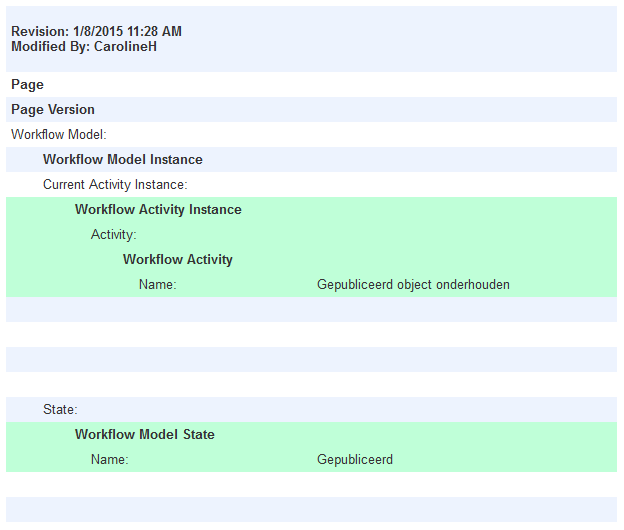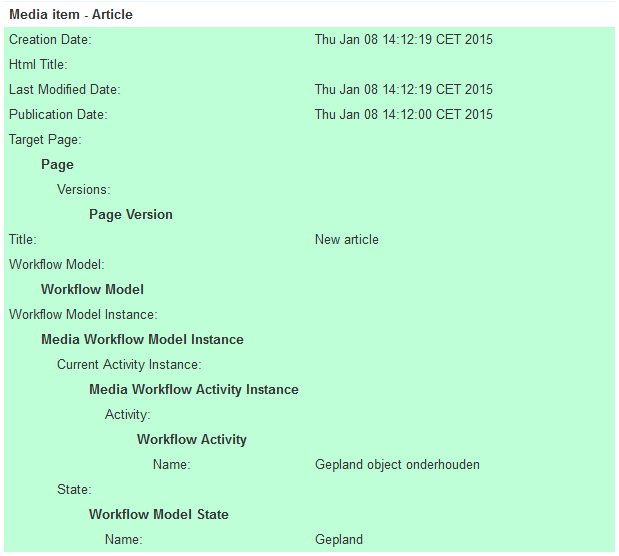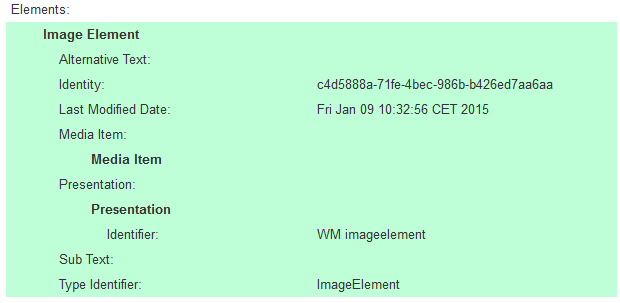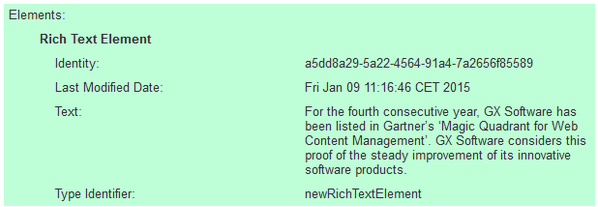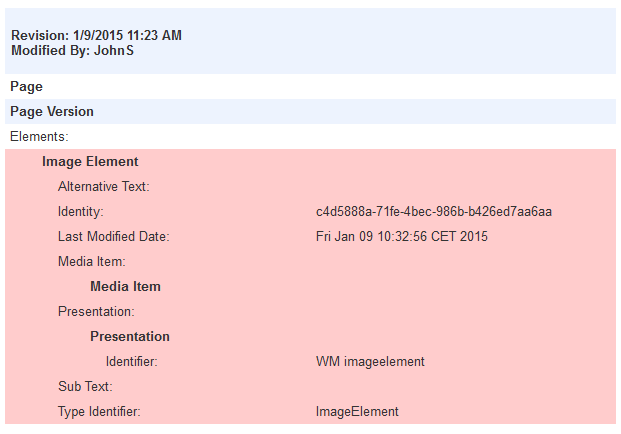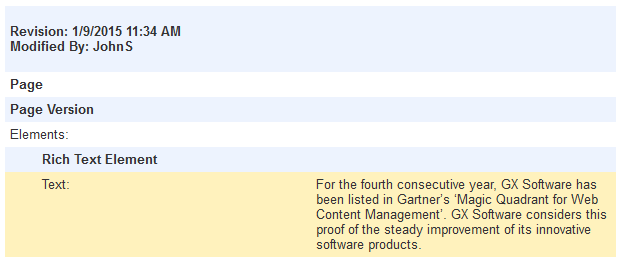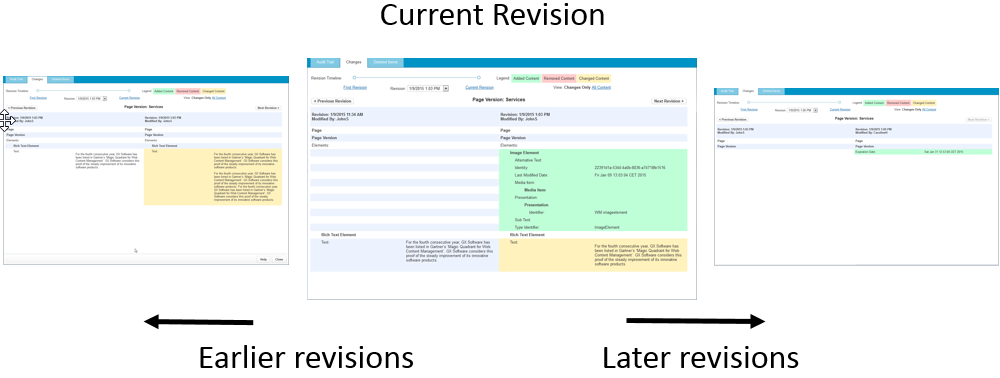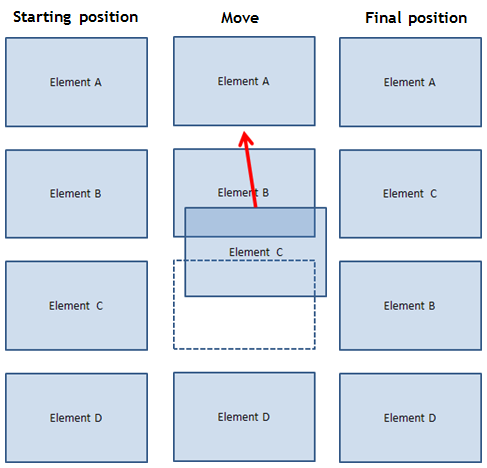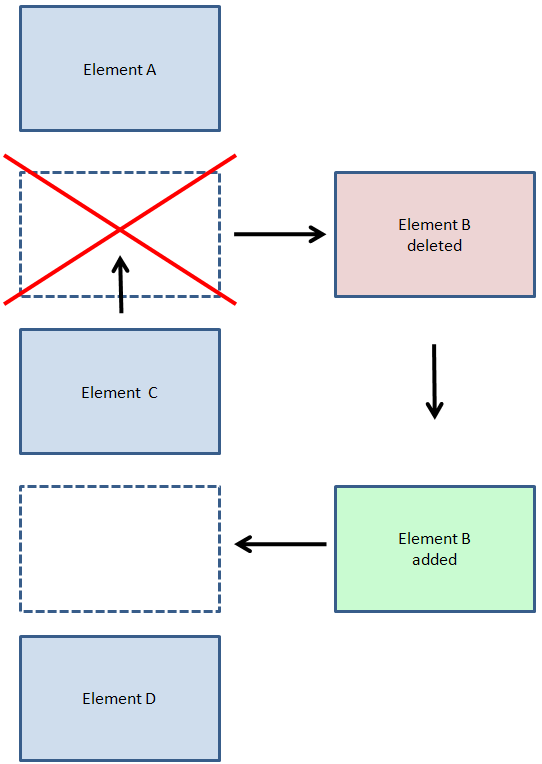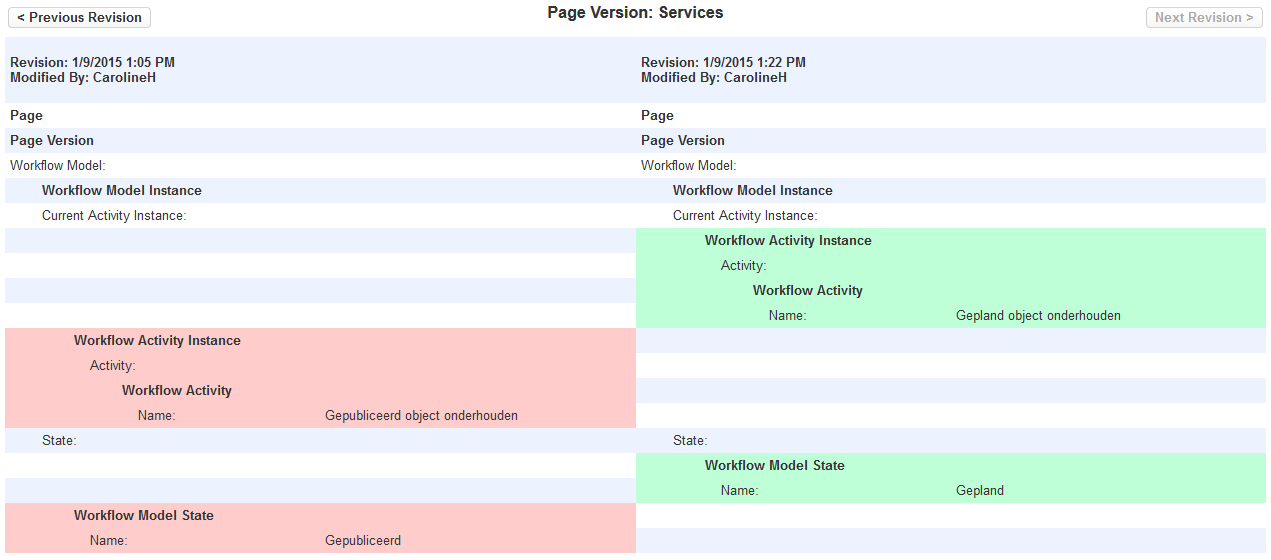The XperienCentral Audit Trail functionality makes it is possible to track and view all modifications made to existing and deleted pages, page sections, articles, custom content items and language labels. You can view the complete change history of these items including who made the change, what the change was, and when it occurred. The ability to view the history of changes made to content is important for purposes of tracking and auditing as well reversing unwanted changes or restoring a page, page section, article, or custom content item to a previous state. By default, only users with the permission to edit the specific page, page section, article, or custom content item can view the audit trail for it. It is also possible to control who can view audit trail information via User Authorization.
While it is possible to track all changes made to individual language labels within XperienCentral, it is not possible to revert these changes.
To view the audit trail for a page, page section, article, or custom content item, perform the following steps:
- Navigate to the content item for which you want to view the audit trail to view it.
- Navigate to content item properties.
- Click the "Status" tab.
- Click [View Audit Trail].
- To view the audit trail for languages and language labels, navigate to the following URL:
http://<server name>/web/mvc/panel?panelid=nl.gx.product.wmpaudittrail.audittrailpanel&webid=<webid>&initialstart=true&langid=<langid>
for example:http://gxsoftware.com/web/mvc/panel?panelid=nl.gx.product.wmpaudittrail.audittrailpanel&webid=26098&initialstart=true&langid=43<server name>is the name of the server on which XperienCentral is running,<webid>is the ID of the web initiative and<langid>is the ID of the language for which you want to see the language label audit trail. The<webid>and<langid>can be retrieved using the JCR Browser and<server name>can be retrieved from Channel Overview.
In This Topic
Audit Trail Tab
On the Audit Trail tab, a record of all changes that have been made to pages, page sections, articles, and custom content items since they were created or since the last time the audit trail was purged can be viewed. For complete information on purging the audit trail, see Purging the Audit Trail.
Selecting a View
At the top of the Audit Trail tab you can select filters to determine which audit trail records and how many per page to view. Audit trail records are always sorted by date with the entry/record with the newest date/timestamp appearing at the top. For each content item, you can select from the following filters to determine the records that are shown:
- Language (see A below) — Select the language version of the page for which you want to view the audit trail. To view records for all available languages, select ‘All’.
- Page version (B) — Select the version of the page or page section for which you want to view the audit trail.
- From date (C) — Specify the start date of the period for which you want to view the audit trail records.
- To date (D) — Specify the end date of the period for which you want to view the audit trail records.
- Entries per page (E) — Select the number of audit trail entries you want to view per page. The options are 10, 25, or 50.
Once you have selected the filter parameters, click [Show]. The audit trail records that match the specified parameters will be shown. For example:
For each audit trail record, the following details are provided to describe the event:
| Column | Description |
|---|---|
| Username | Specifies the name of the user who performed the action. |
| Date | Specifies the local date and time when the action was performed. |
| Action | Specifies the type of action that was performed. See the following section for a description of the actions that are tracked. |
| View changes | Clicking ‘View changes’ next to an entry shows the details of the change(s) in the [Changes] tab. For complete information on interpreting the changes made to a page, page section, article, or custom content item, see the section ‘[Changes] tab’. |
Action Types
An audit trail record is created whenever each of the following actions is performed on an item:
| Column | Description |
|---|---|
| Create | Initial creation of the page, page section, article, custom content item or language label. |
| Update | The content has been updated. The following actions result in an update:
|
| Workflow update | The workflow state is modified. |
| Move | The page has been moved to a different location in the Site Structure Widget. |
| Duplicate | A duplicate has been made of a page, page section, or article. |
Multiple Actions
When a user performs multiple actions within a period of time, a time and date range appears in the "Date" column. The range specifies the beginning and end of the date and time of the session. For example:
In the example above, the user "CarolineH" performed multiple actions within the period 1/8/2015 11:40 AM and 11:45 AM. The details of the multiple actions performed can be viewed by clicking the plus [+] next to "CarolineH" in order to expand the list. The result is a list detailing all actions of the same type that occurred during the session:
Changes Tab
On the Changes tab, all content that has been added, changed, and deleted can be viewed. For each revision, the date and time that the change occurred is listed together with the name of the user who performed the change. The default view always presents one revision of the page, page section, article, or custom content item compared with the revision that immediately precedes it. You can navigate through each revision and see a direct comparison with the previous revision. For each revision, you have the option of viewing just the changes or the entire content, including that which has not changed. See the section ‘Comparing revisions’ for complete information on comparing two revisions with each other.
Viewing Revisions
At the top of the Changes tab, there are controls that allow you to navigate between revisions and to control what content is displayed.
To navigate to the first (initial) revision of a content item, click ‘First revision’ (see A above). To select a revision according to its date/time stamp, select it from the ‘Revision’ drop-down list (B). To view the current revision of the content item, click ‘Current revision’ (C). To switch between viewing all content or only the changes in a revision, click ‘Changes only’ or ‘All content’ (D).
In the audit trail view, two revisions of a content item are always shown. At the top of the audit trail view, the type and name of the content item appears. On the left side, the previous revision is shown and on the right the revision that immediately follows it. At the top of each revision the date and time the revision was saved and the user who performed the change is shown. To navigate to the previous or next revision, click [Previous revision] and to navigate to the next revision, click [Next revision].
In the revision view, a color-coded system is used to denote the three types of changes:
- Content that has been added is shown against a green colored background
- Content that has been removed is shown against a rose colored background
- Content that has been changed is shown against a beige colored background
Interpreting the color coding that appears in the audit trail is described in complete detail in the sections Added Content, Removed Content, and Changed Content.
Page and Page Section Details
In the audit trail, the following details are shown for pages and page sections:
| Column | Description |
|---|---|
| Title | The title of the page or page section. |
| Navigation title | The navigation title of the page or page section. |
| Language | The language version of the page or page section. |
| Publication date | The date and time that the page or page section was created. |
| Expiration date | The date and time that the page or page section will expire. |
| Labels | Labels assigned to this page or page section. |
| Workflow model | The current workflow activity and state for the page or page section. |
For example:
Article Details
In the audit trail, the following details are shown for articles:
| Column | Description |
|---|---|
| Creation date | The date that the article was created. |
| Expiration date | The date that the article was created. |
| HTML title | The HTML title of the article. |
| Last modified date | The date on which the article was last modified. |
| Lead | The lead-in text for the article. |
| Publication date | Same as creation date. |
| Target page | The target page on which the article will be shown. |
| Terms | Terms assigned to this article. |
| Title | The title of the article. |
| Workflow model | The current workflow activity and state for the article. |
For example:
Element Details
In the audit trail, all details of elements are shown. The details are presented in a hierarchical structure that contains generic information that is then broken down into fine detail in outline fashion. Element details are shown under the "Elements" heading. The name of the element is shown in bold the next level in and then the specific details for the element appear indented below the element name. The audit trail record for each element type shows details specific to it. For information on a particular field, compare the audit trail record to the fields that appear in the element itself.
Added Content
When content is added, it is shown in the audit trail against a green colored background in the revision in which it was added. Added content includes:
- Elements (rich text, paragraph, image, media overview, and so forth).
- Text added to a property field in an element.
- Text or details added to fields for page properties including navigation title, publication, and expiration date.
When an element is added, the entire element details are shown as added. For example:
When text or detail is added to a field in an element, only the particular field that was added is highlighted. The following is an example of rich text added:
The following is an example of an expiration date added to a page:
Removed Content
When content is removed, it is shown in the audit trail details against a rose colored background. Removed content includes:
- Deleting an element.
- Deleting the text or removing the details from a field of an element.
- Deleting the text or removing the details from a field of the page properties.
The following example shows an image element that has been deleted from a page:
When the text in a field or a detail for an element is removed, only the particular field that was removed is highlighted. In the following example, the expiration date for a page has been removed:
Changed Content
When content is changed, it is shown in the audit trail details against a beige-colored background. Changed content includes:
- Modifying text in a rich text element.
- Modifying the text or details in a field of an element.
- Modifying the text or details in a field of the page properties.
When the text in a field or a detail for an element is modified, only the particular field that was modified is highlighted. In the following download element example, the target file for the download (Url) has been modified:
When the text in a rich text element is modified, the entire rich text element is shown as having been changed as opposed to individual bits of text. To determine what changed in the rich text element, compare it side by side immediate revision prior to it. See the following section for complete information on performing side by side comparisons of content item revisions.
Comparing Revisions
The color coding denoting added, removed, and changed content makes it easy to quickly interpret how content has been changed between two revisions. Because two revisions are always shown side by side, you can not only clearly see the changes that have been made but also the previous state of the part of the content item that has been changed.
By selecting the view ‘Changes only’ you can see summary of only the changes that occurred between two revisions instead of the complete content of the item. For pages, page sections, articles, and custom content items containing a lot of content, this makes it easier to locate the changes.
To navigate between revisions, click [Next revision] or [Previous revision]. In this way you can step through the entire audit trail history of the content item:
Moving Elements
When you move an element using drag and drop, the action is shown in the audit trail as an add/delete action instead of as changed content. Consider the example below. Four elements appear on a page (Element A, Element B, Element C, and Element D), ordered from top to bottom as shown. Element C is then moved to the position below Element A — The result is represented below right (A, C, B, D):
In the audit trail, this action will be represented as the deletion of Element B in the position under Element A and then the re-adding of it in the position below Element C:
Workflow State Changes
Changing the workflow state of a content item is shown in the audit trail as a pair of add/delete actions instead of as changed content. For example:
In the example above, the workflow state of the content item has been changed from Published to Planned. In the audit trail, the actions that are shown as having occurred are:
- Workflow activity "Maintained published object" has been deleted.
- Workflow model state Published has been deleted.
- Workflow activity "Maintain planned object" has been added.
- Workflow model state Planned has been added.
Deleted Items Tab
On the Deleted Items tab you can see all content objects/items that have been deleted since the initial creation of the website or since the last time the audit trail was purged. While the objects themselves cannot be restored once deleted, you can view the audit trail of deleted content items/objects (pages, page sections, articles, and custom content items). For complete information on purging the audit trail, see the section Purging the Audit Trail.
For each content type (page, page section, article or custom content item), the following information is provided:
| Column | Description |
|---|---|
| Title | The title of the deleted item (not the navigation, HTML, or URL title). |
| Content type | The content type of the deleted item (page, page section, article, or custom content item). |
| Date and time of deletion | The local date and time when the item was deleted. |
| Username | The name of the user who deleted the item. |
| ID | The unique identifier of the deleted item. |
| Original path | The original path of the deleted item. For pages and page sections, the parent hierarchy in the page/page section tree is shown. For articles and custom content items, the original path is always ‘Media repository’. Pages deleted from the ‘Orphan pages’ tree do not include a parent page hierarchy. |
| Audit trail | A link that allows you to view the audit trail of the deleted item. |
Sorting Items in the Deleted Items Tab
Deleted items can be sorted in ascending or descending alphabetical order according to the following column headings:
- Title
- Content type
- Username
- Original path
You can also sort deleted items in ascending or descending numerical order according to the column headings. To change the sort order, click the column heading of the parameter by which you want to sort the deleted items. The current sort order is identified by the dark blue triangle that appears to the right of the column header by which the deleted items are currently sorted. The down facing arrow indicates that the sort order is currently descending alphabetical or numerical order. The up facing arrow indicates that the sort order is currently ascending alphabetical or numerical order
Purging the Audit Trail
Using the Audit Trail tab of the XperienCentral Setup Tool, you can purge the audit trail for existing and deleted pages, page sections, articles, and custom content items. You can purge all audit trail information completely or tracked changes up to and including a specific date.
- For legal reasons, some entities are required to keep audit trail information for a specific duration or dating back to a specific time. Before purging audit trail information, be certain that no restrictions apply to the information in question.
- When audit trail information is purged, this has a direct effect on what information is available. Because a purge of the audit trail begins with the inception of a content item, you will no longer be able to see who initially created the first version. Depending on how/when you purge the audit trail, you may also see the message "No entries found" when viewingw the audit trail for a content item.
- The purge action cannot be undone.
For complete information on purging information from the audit trail, see Audit Trail.






